Disaster Adventure in Space: Coriolis’ The Last Voyage of the Ghazali
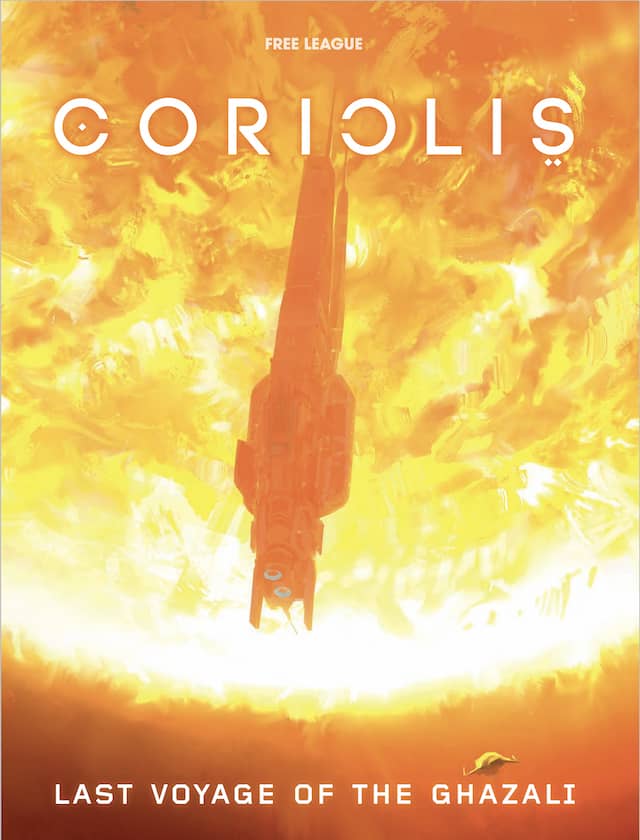
How does one present a science fiction roleplaying game to a group to introduce both the setting, the basic mechanics, and give a good flavor of how it will run yet extend beyond the typical rulebook starter adventure? Free League Publishing’s Coriolis is called “Arabian Nights in space,” and its tone and setting are evocative and fresh. Set far in the future in an area of space called the Third Horizon, humankind lives and thrives on a variety of planets and space stations. While many factions exist, one major divide is omnipresent: the Firstcomers and the Zenithians. The Firstcomers fled the Second Horizon, and after a decades-long war called the Portal Wars, were eventually cut off from that area of space. Meanwhile, centuries before the portals that allow travel among the stars were found, a generation ship called Zenith left Earth for the star called Kua. Once there, they found the Firstcomers.
With its Middle Eastern aesthetic, its religious undertones (a number of icons are revered — or not — among the population), and the Emissaries — mysterious entities who recently appeared and seem to be associated with the Icons — the game has more than the traditional Western culture-based science fiction setting many RPGs call home. Introducing a playing group to the game can be a challenge, and that’s where The Last Voyage of the Ghazali comes in.
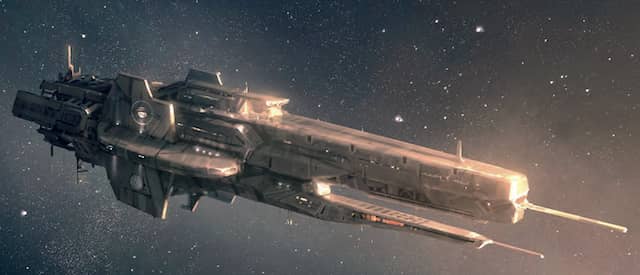
Coriolis is an RPG that feels like in can encompass both the wonder and the grandeur of megastructures and the unknown. Both haunting (references to the Dark between the Stars) and individual focused, the setting thrives with players engaging with the hostile vacuum of space and the selfish and often foolish actions of the people who populate the Third Horizon.
The Last Voyage of the Ghazali is, in its shortest description, a disaster adventure. Think The Towering Inferno in space. The adventure is a great starting adventure, for it introduces both the richness of the setting and keeps the focus on characters and basic game mechanics. Plus, it’s a thrilling.
The set up: The players are engaged in a rescue effort to answer a distress call from a gas mine around the Taoan gas giant. A fleet was hastily assembled, including the Ghazali, a decommissioned star liner that has been extensively modified to hold hundreds of stasis units — the devices that people go into to safely jump through the portals that connect the systems. Another ship, the Zafirah, enters the portal to Taoan, and everything goes wrong. The portal experiences an unexpected energy surge that smacks the Ghazali and the fleet accompanying it. The Ghazali’s engines are destroyed; its crew, who was performing last minute checks before going in stasis, is killed; and the ship itself is knocked off course and into the gravitational pull of the star Hamura. The backup systems eventually activate and wake the players from the stasis. And they know, oh, they know, something has gone very wrong.
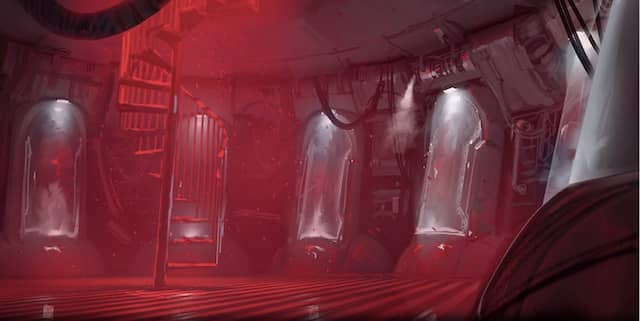
Goal: Escape with their lives and as many people as they can save.
The adventure is divided into three acts, which can have varying lengths based on how the players cope with the situation. Eventually, time in game will become important to track — but only after the first act is completed.
The first act is all about dealing with the disorientation of finding themselves awake with and with a number of others in stasis units around them dead. Emergency lights and warnings are in full swing. It is immediately apparent to the players that something has gone horribly wrong. The players are thrust into the position of figuring out what happened and how to deal with it because no one else is around them to assist.
The trail leads, ultimately to interacting with the ship’s AI, Suleiman. Along the way, the players will encounter desperate rescue workers, who are seeking medical aid and escape. The players will also see signs of a creature, which they may not recognize. These are nektara, bipedal predators that work in packs. A few escaped a containment pod and are now roaming the ducts and hallways. They will figure more prominently in Act 3, but like any good horror or thriller, their presence and danger is witnessed early on.
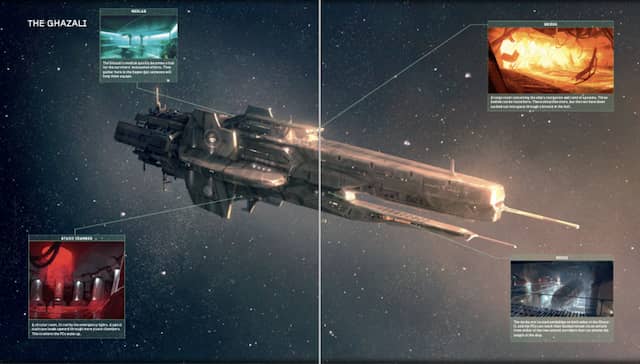
The GM can also spend Darkness Points, the meta currency used in Coriolis that can be used to add complications. For Act 1, the adventure provides some examples, including a fire and explosive decompression.
Once the players recognize they need to talk to the AI, they will obtain useful, but limited information. If they perform particularly well on their rolls, they may learn valuable information. They will learn that the Ghazali is doomed; the players have no way of preventing its eventual burning up in the star. This is when the clock starts ticking. The players have 18 hours before before the ship is doomed. The escape pods are not strong enough to escape eventual burning up in the star, but the Hamurabi Station is the nearest safe port, which a number of the ships attached to the Ghazali (perhaps include ginger the player’s own), should prove sufficient.
If they’re lucky, they’ll also learn that 30 nektara were aboard, and that the ship reports upwards of 50 lifeforms.
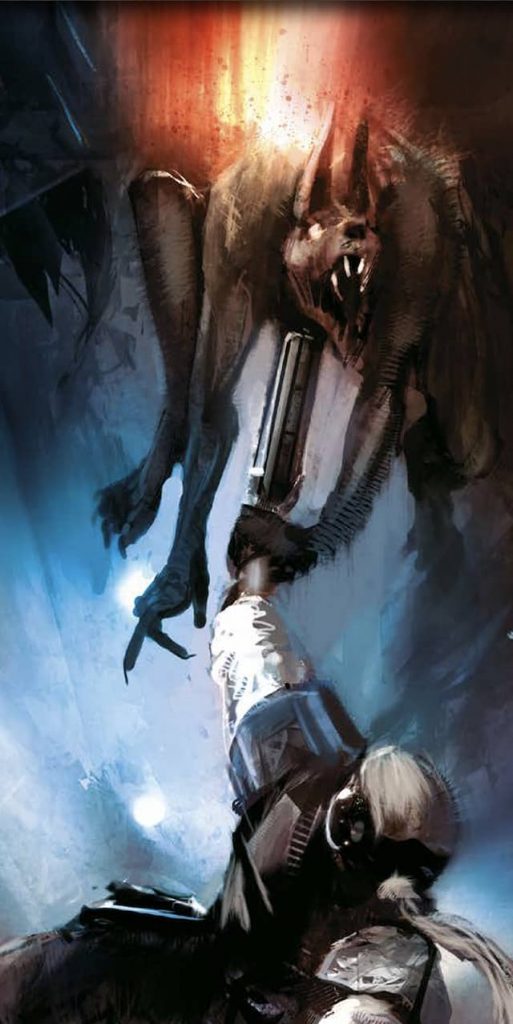
Act 2 presents numerous options, but the drive will be forming an escape plan. The adventure delves into the four most likely events and areas: the bridge, the medlab, rescuing trapped passengers, and fighting the nektara. The medlab harbors a number of survivors, and here, the players encounter the factions and intrigue of the Third Horizon. One of the NPCs, Khomina is a mystic. Mystics are individuals who have, since the arrival of the mysterious Emissaries, developed powers like telekinesis and so on. Khomina has, in fact, met one of the Emissaries who claims to be the revered Judge Icon.
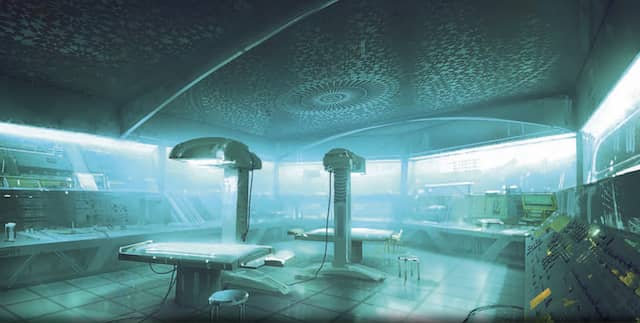
Also in the medlab is Brother Ramas, a member of the Order of the Pariah, a major faction in the game. Also known as the Samaritans, the Order is noted for its medical expertise (of which Ramas is a doctor) and its zealous persecution of heretics, which is believes those who consider the Emissary the Judge Icon are. As soon as Khomina mentions her visit to the Judge Emissary — her visit included a vision and a certainty that she will die falling into Hamura’s star — Ramas will insist on her being detained. He will go so far as refusing medical care to the players if they do not assist in this effort. If they refuse, Ramas will ask other passengers. Depending on how the players react — including their character’s background and primary drivers — conflict could result. Additionally, Khomina will refuse to leave the ship as part of the evacuation. Something even Ramas cannot accept. Will the players insist on taking Khomina with them by force? Or leave her to her fate? Other conflicts and NPCs provide other such choices.
The bridge, while badly damaged, can provide clues to what happens to the Ghazali, including the Third Horizon’s version of the black box: the emerald disk. The adventure provides a strong rationale for going to the bridge: that’s where the weapons are, secured in a locker. These weapons will prove helpful in the battle with the nektaras, who will attack during this act. Further upping the ante for the players and the survivors to make haste in their escape from the doomed starliner.
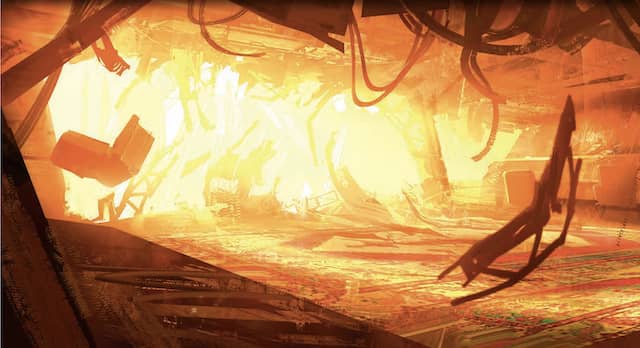
Another complicating incident is when the players learn of the trapped passengers. Fourteen people are trapped in the ship’s chapel. The damage to the ship means that the nearby escape pods are destroyed, and the trapped passengers have only four spacesuits among them. To reach them, the players will need to conduct a series of spacewalks — a dangerous proposition. If the players determine to abandon the trapped passengers to their fate, they will likely lose all credibility with the other survivors. This may not matter to the players, though if the others survive, they may give unfavorable after-action reports and talk to journalists.
Once ten hours of the clock elapses, the players learn that the reactor has become unstable. The ship’s AI informs them they have an hour to make their escape. Of course, one last challenge remains — assuming they have survived to get to their escape ship. That ship’s ignition sequence, requiring repairs.
As the Ghazali’s reactor heads to explosion, the players make a final set of repairs and make their escape — presumably with other survivors. They can also resume others who managed to escape via emergency pods. When they arrive at Hamurabi Station, they are greeted as heroes.
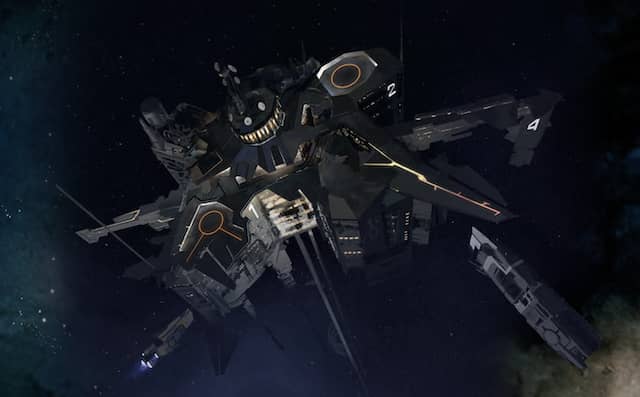
The rest of the booklet provides an epilogue and introduces Hamurabi Station, including key locations and NPCs.
The Last Voyage of the Ghazali is the prelude adventure to the massive, two volume Mercy of the Icons. One can play the Last Voyage as a standalone, and one can play it before embarking on The Last Emissary, the first part of Mercy of the Icons. The epilogue and a vision by Khomina along with several of the NPCs make appearances in that campaign. The epilogue may include details that pertain to that campaign, so the GM should adjust as necessary.
In the final summation, The Last Voyage of the Ghazali is an excellent starting adventure for a group new to Coriolis. A solid introduction that does not forego the fantastic elements of the RPG in its setting or factional setup — along with being a thrilling space adventure.
You can pickup Coriolis and The Last Voyage of the Ghazali at Free League Publishing’s webstore.
Patrick Kanouse encountered Traveller and Star Frontiers in the early 1980s, which he then subjected his brother to many games of. Outside of RPGs, he is a fiction writer, avid tabletop roleplaying game master, and new convert to war gaming. His last post for Black Gate was Exploring Degenesis Rebirth: Primal Punk. You can follow him and his brother at Two Brothers Gaming as they play any number of RPGs. Twitter: @twobrothersgam8. Facebook: Two Brothers Gaming and Solo Twilight: 2000 game.